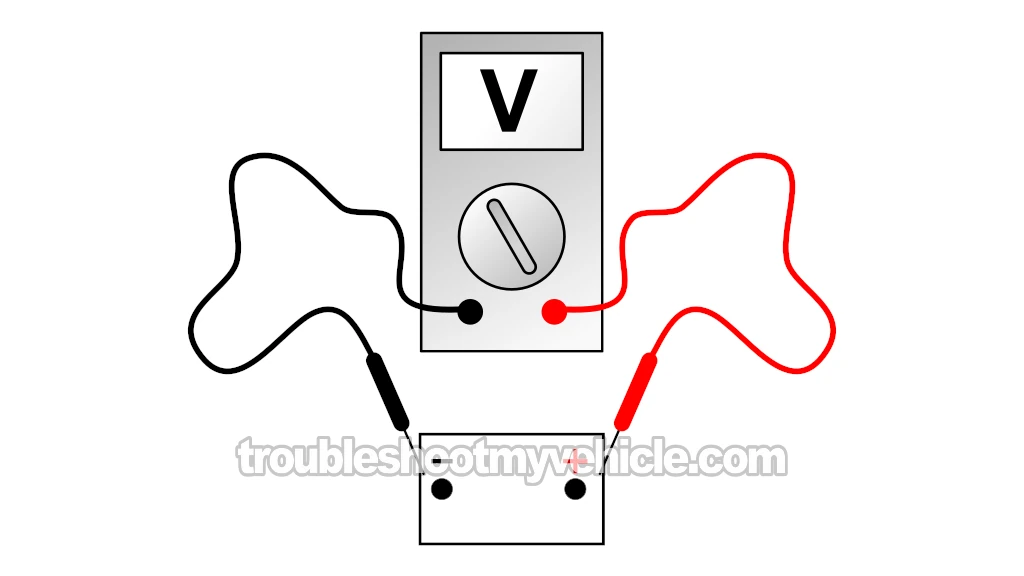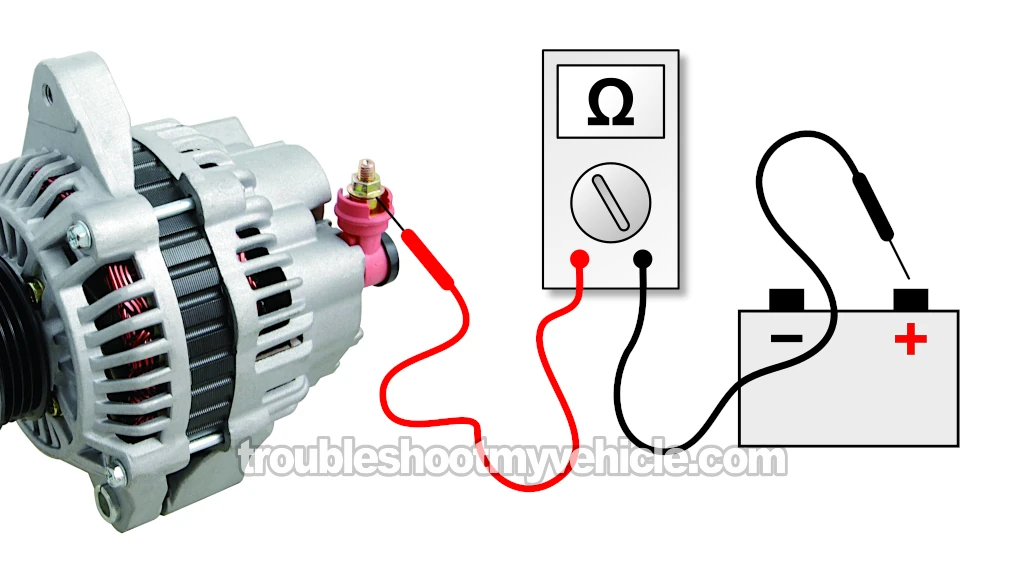
In this tutorial, I'll explain how to do an easy alternator test on your Honda Civic with a simple multimeter. No need for expensive diagnostic testing equipment.
The entire test is explained in a step-by-step manner and can be done in under 10 minutes.
Contents of this tutorial:
APPLIES TO: This tutorial applies to the following vehicles.
- 1.5L Honda Civic CX: 1992, 1993, 1994, 1995.
- 1.5L Honda Civic DX: 1992, 1993, 1994, 1995.
- 1.5L Honda Civic EX: 1992, 1993, 1994, 1995.
- 1.5L Honda Civic LX: 1992, 1993, 1994, 1995.
NOTE: One last thing before we start, you'll notice that the photos I'm using in this article show the alternator off of the Honda Civic but this is just to make the explanation of the test easier. When you do the test on your Honda Civic, it will be an on-car test, so don't remove the alternator from the car.
Symptoms Of A Bad Alternator
The alternator in your 1992–1995 1.5L Honda Civic plays a crucial role in keeping your car's electrical system running smoothly.
Its main job is to generate electricity to power the vehicle's electrical components, like the headlights, radio, and fuel injection system, while the engine is running.
At the same time, it charges the battery so that it's ready to crank the engine the next time you start your car.
The most common symptom of a bad alternator are:
- Charge light is ON: The charge light (also known as the battery light) is illuminated on your instrument cluster, shining bright to signal an issue.
- Dim headlights: When driving at night with the headlights on, they glow very dim, indicating the alternator isn't providing enough power.
- Vehicle won't crank but starts with a jump: The car doesn't crank on its own, but when someone helps you jump-start it, your Honda starts easily.
- Battery frequently dies: You constantly have to recharge the battery or rely on jump starts. After starting, the vehicle only runs for a short time before stalling again.
- Flickering or intermittent lights: The headlights or interior lights flicker or become brighter and dimmer while driving, signaling inconsistent alternator output.
- Strange noises: A bad alternator can cause a whining or grinding noise, which might come from worn-out bearings inside the alternator.
- Weak or Dead Battery: The battery appears weak or dies repeatedly, even though it has been recently replaced.
TEST 1: Testing Battery Voltage With A Multimeter

Alright, let's get this show on the road! The first step is to test the battery's voltage with the engine running. This quick and easy multimeter test will tell you if the alternator is (or not) charging the battery.
To perform this test successfully, the battery in your Honda Civic needs to be fully charged. Why? Because the battery needs enough power to:
- Crank and start the engine.
- Keep the engine running for about 10 minutes while you complete the test.
Don't have a multimeter or need to upgrade yours? This is the one I use and recommend: Tekpower TP8268 AC/DC Auto/Manual Range Digital Multimeter (Amazon affiliate link).
NOTE: Be careful, the engine will be running. Use extreme caution and avoid contact with moving parts, especially around the drive belt and pulley. Keep hands and loose clothing away from all engine components.
Alright, let's get testing:
- 1
Set your multimeter to Volts DC mode.
- 2
Crank up and start your Honda Civic.
- 3
With the multimeter test leads, probe the battery terminals.
Red lead on the battery positive and the black lead on the negative (-) terminal. - 4
You'll see one of two results:
1.) A steady 13.5 to 14.5 Volts DC.
2.) Or 12.5 Volts DC that will steadily decrease as long as the engine is running. - 5
With the engine still running, you need to turn everything on, inside your Honda Civic, that you can possibly turn on.
For example, turn on the A/C or Heater on high and then eyeball the multimeter. Then turn on the windshield wipers on high, and again take a look at your multimeter. Now, turn on the radio, turn on anything and everything that can be turned on that uses electricity to run. - 6
You'll see one of two things:
1.) Either your multimeter will register a nice and steady 13.5 to 14.5 voltage (in Volts DC) no matter what you turned on inside the Civic.
2.) The voltage will decrease from 12.5 Volts DC to 10-9 Volts DC the more stuff you turn on and the longer your Honda Civic stays running.
Let's interpret your multimeter test results:
CASE 1: Your multimeter registered 13.5 to 14.5 Volts. This is good and it tells you that the alternator is working and is charging the battery and providing enough juice for the electrical needs of your Honda Civic.
No further testing is required, since this multimeter test result eliminates the alternator on your Honda as bad.
CASE 2: Your multimeter registered a voltage that steadily dropped down to 9 Volts. This is a clear indication that your Honda's alternator IS NOT charging the battery.
Replacing the alternator at this point usually solves around 90% of the no-charge problems. I suggest two more easy tests to be absolutely sure it is bad. For the first test of the two, go to: TEST 2: Testing The Continuity Of The Bat (+) Circuit.
TEST 2: Testing The Continuity Of The Bat (+) Circuit

All the electrical power the alternator produces —to charge the battery and power your Honda's electrical systems— flows through a single 80 Amp fuse!
This fuse is Fuse #41 (80A) located in the under-hood fuse/relay box of your 1.5L Honda Civic.
If this fuse is blown, the alternator might still be working, but its output won't reach the battery or any electrical accessory that needs a steady supply of voltage and amperage.
In this step, you're going to check that this fuse is in good condition. We'll do this by performing a simple continuity test on the cable that connects the alternator to the battery's positive (+) post.
NOTE: This test is done with the engine OFF.
This is what you'll need to do:
- 1
Disconnect the battery negative (-) cable terminal from the battery negative (-) post. This cable must remain disconnected throughout the entire test.
IMPORTANT: Don't continue to the next step without first doing this. - 2
Leave the positive (+) battery cable connected to the battery positive (+) post.
- 3
Set your multimeter to Ohms mode.
- 4
Connect your multimeter's red test lead on the Batt + stud on the back of the alternator. The arrow in the photo points to this stud.
NOTE: Don't disconnect the battery cable from the rear of the alternator. - 5
With the black multimeter test lead, probe the center of the battery positive (+) post.
- 6
You'll get one of two results:
1.) If Fuse 41 (80A) is blown, your multimeter will indicate an open-circuit problem with a reading of OL (which means over limit).
2.) If Fuse 41 is OK and not blown, your multimeter will register continuity with a reading of 0.5 Ohms or less.
OK, now that the testing part is done, let's take a look at what your results mean:
CASE 1: Your multimeter registered continuity. This is the correct and expected test result and it indicates that Fuse 41 is OK (not blown).
The last test to do also involves checking the condition of another fuse. Except that this is just a regular plastic blade type fuse found in the under-dash fuse/relay box. For this test, go to: TEST 3: Checking The Alternator Fuse.
CASE 2: Your multimeter DID NOT register 0.5 Ohms, it registered OL. This result tells you that the fuse is blown and this will keep the alternator from charging the battery.
Replace the fuse and retest. Replacing the fuse should solve your no charge condition. You'll have to investigate the reason this Inline Fusible Link or fuse blew, since they don't go bad for no particular reason.
TEST 3: Checking The Alternator Fuse

In this section, we're gonna check that the black with yellow stripe (BLK/YEL) wire of the alternator's 4-wire connector has 10 to 12 Volts with the key on but engine off (KOEO).
The BLK/YEL wire connects to the female terminal I've labeled with the letters "IG" in the illustration above.
The BLK/YEL wire gets power from a fuse located in the under-dash fuse and relay box inside your Civic.
Depending on the specific model year of your 1.5L Civic, these are its locations:
- 1992: Fuse #24 (15A) (under-dash fuse/relay box).
- 1993: Fuse #24 (15A) (under-dash fuse/relay box).
- 1994:
- Fuse #12 (15A) without airbags (under-dash fuse/relay box).
- Fuse #24 (15A) with airbags (SRS fuse box).
- 1995:
- Fuse #12 (15A) without airbags (under-dash fuse/relay box).
- Fuse #24 (15A) with airbags (SRS fuse box).
OK, let's get started:
- 1
Reconnect the battery to its battery negative (-) cable.
- 2
Locate the fuse #24 (or fuse #12) -depending on the model year of your particular Civic and whether it's equipped with airbags or not.
- 3
Remove the fuse and check that it's not blown.
- 4
If it is blown, replace it with a new one and repeat TEST 1.
Let's take a look at what your test results mean:
CASE 1: The fuse is NOT blown. This is the correct and expected test result. You can conclude that the alternator is bad and needs to be replaced.
CASE 2: The fuse IS blown. Replace the fuse with another of the same amperage rating and start the car and check to see if the alternator is now charging the battery by repeating TEST 1.
More 1.5L Honda Civic Tutorials
You can find all of the 1.5L Honda articles here: 1.5L Honda Civic Index Of Articles.
Here's a sample of the tutorials you'll find in the index:
- How To Test The MAP Sensor (1992-1995 1.5L Honda Civic).
- How To Test The Fuel Injectors (1992-1995 1.5L Honda Civic).
- How To Test The Throttle Position Sensor (1992-1995 1.5L Honda Civic).
- How To Test The Igniter, Ignition Coil Accord, Civic, CRV, and Odyssey (at: easyautodiagnostics.com).

If this info saved the day, buy me a beer!


